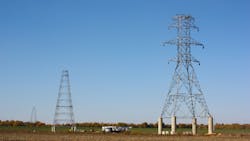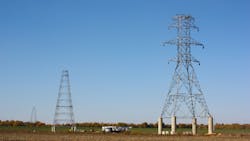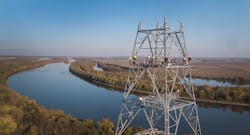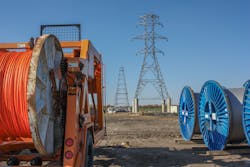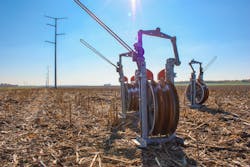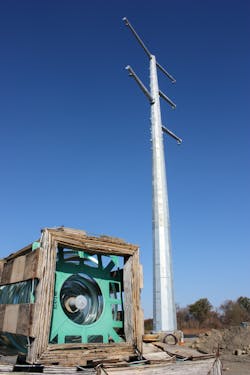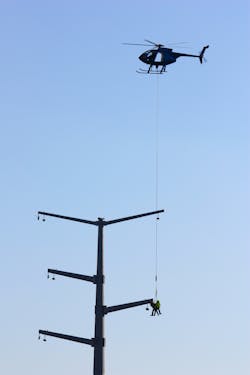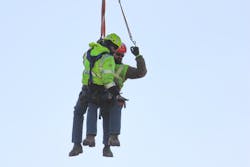The Illinois Rivers Transmission Project: Ambitious, Complicated, Successful
When Ameren Transmission Co. of Illinois energized the last line segment of its 375-mile (604-km) Illinois Rivers project in December 2020, the wholly owned subsidiary of Ameren Corp. marked completion of its most ambitious transmission project to date. While extremely complicated, the project was critical to connect wind power to the regional energy grid. Projects like the complex Illinois Rivers project are increasingly important as the industry transitions from thermal generation to renewable generation resources.
The Illinois Rivers project was 12 years in the making. In 2008, the Mid-Continent Independent System Operator (MISO) began planning studies to identify regional transmission projects that would enable wind development to support states in the Midwest in meeting their renewable portfolio standards (RPS). MISO developed a regional portfolio of projects known as multi-value projects (MVP), which the MISO board approved in 2011. This portfolio would improve reliability for customers across the region and expand access to renewable resources. After MISO calculated what the benefits would be for completing the MVP portfolio and compared it to the cost of constructing new transmission projects, ranging from 1.8 to 3.0, the operator decided to proceed.
Part of the MISO MVP portfolio, the Illinois Rivers project was completed safely and on budget. The $1.4 billion project consisted of constructing a new 375-mile, 345,000-V transmission line from Palmyra, Missouri — crossing east over the Mississippi River and spanning Illinois — to the Indiana border. The project crossed the Mississippi River once and the Illinois River twice. It included constructing six new substations and expanding four existing ones — one substation in Missouri and nine in Illinois — and upgrades to the existing transmission system to support the integration of the new 345,000-V transmission line. The project provided local and regional economic benefits, as well as improved grid reliability, increased transmission capacity, access to lower-cost energy and electricity from renewable sources for Midwestern families and businesses.
Charting A Course
Once MISO approved the project, Ameren Transmission determined primary and alternate routes to connect each of the 10 substations, which would serve as off-ramps to move renewable energy from west to east. In determining routes, the project team factored in minimizing impacts to the community and environment while containing costs.
The project team engaged in extensive community outreach, holding 98 public open houses in 21 counties. The open houses enabled community leaders, landowners and other key stakeholders to learn about the project, the proposed routes and the construction process. The project team incorporated valuable stakeholder feedback from these open houses to further support the routes Ameren Transmission would propose to the Illinois Commerce Commission (ICC), which ultimately determined which route to pursue.
Following the public process, Ameren Transmission filed for a certificate of public convenience and necessity (CPCN), which presented primary and alternate routes for the project, as well as estimated costs and benefits, with the ICC in January 2013. The CPCN gave Ameren Transmission the right to own, operate and maintain the transmission facilities, including the right to pursue the property rights needed to construct the line. The ICC approved a portion of the project in August 2013.
Following rehearing for several line segments, the ICC approved the remaining portions of the project in February 2014. Although the route approved was largely constructible, Ameren Transmission returned to the ICC a few times to seek minor modifications to the route, which ultimately were approved. The CPCN case and the following real estate acquisition efforts generated legal issues that were reviewed by the Illinois Court of Appeals and, eventually, the Illinois Supreme Court. The project even gave rise to an appeal to the U.S. Supreme Court, which the court declined to hear. The appeals and challenges did not derail the project.
Paving The Way
Once the final route was approved, Ameren executed an extensive real estate acquisition strategy that involved acquiring easement rights on nearly 1400 different tracts of land from almost 1200 different landowners. The team contacted all landowners simultaneously and began negotiating to acquire the necessary easement rights. Ameren acquired its first property in 2014 and the final easement was executed in early 2020.
Along with the acquisition of easements, environmental permits had to be secured, which meant conducting studies of endangered species, wetlands mitigations, land disturbance and historical preservation. Of particular importance, the project needed to protect the Indiana bat, which is a federally designated endangered species that roosts in trees along the route of the Illinois Rivers project. To minimize any impacts on the bat habitat, the right-of-way clearing had to be performed during non-roosting seasons, between November and March. This presented significant schedule challenges. Ameren Transmission had to balance the availability of right-of-way from easement acquisition activities, coordination of environmental studies and clearing activities to ensure construction crews could work on long and continuous sections of right-of-way, so the project could stay on schedule.
To coordinate all this activity, the team constructed a transmission line tracker tool that provided a simple visual for team members to view the status of all real estate, environmental, clearing and construction work on each individual parcel. This enabled team members to prioritize better and focus on specific areas of the different line segments for maximum efficiency and continuity of work with the different construction contractors.
In addition to the environmental studies and permits, Ameren Transmission coordinated with local communities and other stakeholders. It worked with more than 80 different county and township road commissioners to allow for continued use of roads throughout the project. The project team determined all the different haul routes from material laydown yards to each of the different right-of-way entry points. Once these roads were surveyed to obtain a baseline of their current condition, Ameren Transmission worked with each commissioner to establish ongoing plans and communication for use of the roads while the project was constructed.
In addition to permits for crossing roads, Ameren Transmission obtained 45 levee and drainage agreements, as well as new license agreements for 28 railroad and pipeline crossings.
Easy Access To Materials
To effectively manage the massive construction effort, materials had to be conveniently located so construction crews could be productive throughout the project. Consequently, the project team established material laydown and staging hubs at four strategic locations along the route. Material was shipped to these locations where it was received, inventoried and staged for construction crews. These crews traveled to the laydown facilities, where material was issued as the line construction progressed. This rigorous level of material tracking saved significant time and expense, as the project team could see material inventories, what material was available to support construction and what material had been issued to the crews.
Construction crews who picked up the material then traversed the agreed-upon haul routes between the laydown facility and the entrance to the right-of-way. Once off the roads, access paths were developed to get the material and equipment back to each structure location. Team members reviewed and identified all right-of-way access points and access paths for the construction crews to traverse so they could get back to each structure. The team then developed access maps that identified all access points and improvements that needed to be made to the access — such as culvert installations, low-water crossings and matting of sensitive areas — to facilitate transporting materials and equipment to the structure locations.
The line construction involved installing more than 2300 engineered steel monopoles on concrete drilled pier foundations that ranged in diameter from 7 ft to 12 ft (2.1 m to 3.7 m) and reached depths between 30 ft and 60 ft (9.1 m and 18.2 m). The line construction consisted of installing the structures in two to four slip fit sections, with the poles ranging in height from 80 ft to 140 ft (24.4 m to 42.7 m). The project used a bundled aluminum conductor steel-reinforced (ACSS) conductor over the entirety of the line. Ameren Transmission contracted construction of the line to one civil and three different electrical contractors, using a fixed-unit-price contracting structure. This approach enabled Ameren Transmission to put contracts in place early in the project to better align the construction schedule while simultaneously transferring the production risk to the contractor.
Crossing Two Rivers Three Times
Three major river crossings along the 375-mile route — two crossing the Illinois River and one crossing the Mississippi River — required special attention from a permitting, design and constructability perspective. The river crossings needed additional approvals from the U.S. Army Corps of Engineers (USACE), including obtaining a Section 408 permit to construct improvements on or near a USACE levee and a Section 10 permit to pull conductor across a navigable waterway. Ameren Transmission worked extensively with levee and drainage districts as they reviewed the design and placement of the structures, to obtain a 408 endorsement letter from the drainage district to the USACE.
Additionally, two towers planned for construction on two USACE-owned islands in the Mississippi River crossing presented challenges for getting material, as well as construction equipment and resources, onto the islands to build the towers. Ameren Transmission worked with the USACE and U.S. Fish and Wildlife Service to design and construct a causeway in the river so barges could bring material and equipment down the river and offload it onto the islands. A condition of the permitting included mitigation of vegetation lost during clearing of the corridor, which included planting and monitoring more than 8000 trees and shrubs on three separate USACE-owned islands downstream from the corridor crossing.
The river crossing structures were some of the largest ever installed in the Ameren Transmission system, extending nearly 500 ft (152 m) tall to span nearly 4000 ft (1219 m) across the river while maintaining required clearances to the river below. To construct these towers, the base sections were erected using a conventional crane. The top sections of the towers were assembled on the ground. Then helicopters flew linemen to the top of the base tower sections. The top tower sections and tower arms were picked up by a sky crane and flown to the top of the tower, where the linemen received the tower section and bolted it together.
From New To Existing
The substations scope consisted of constructing six new 345/138-kV substations and expanding four existing substations to include 345-kV bus arrangements with 345/138-kV transformations. In addition, existing transmission lines had to be rerouted into the new substations to fully integrate the new transmission line into the existing transmission network.
Construction of the first substation began in late 2013. During 2015 and 2016, all 10 substation projects were constructed simultaneously. To balance the construction resources needed to complete the work, the design team used standardized design assemblies and material to develop detailed, uniform substation units. The contracts were competitively bid on these units to select contractors early in the program while transferring the production risk to the contractor. Because the contractors were selected early in the program, the timing of specific scopes could be spaced out, which provided work continuity for the contractors’ core teams.
As construction of the substations neared completion, the project team developed detailed plans for how the existing transmission lines would be routed into the new substations and, ultimately, how the new Illinois Rivers transmission line would be brought on-line and integrated into the existing transmission infrastructure. Accomplishing the transition on a project of this size took significant outage planning and coordination. Over the course of several months, the project team planned an outage sequence schedule at each substation site. The schedules were reviewed and updated quarterly. The team identified and successfully executed over 300 outage events to integrate the line into the existing transmission system.
The Illinois Rivers project began energizing substations in the fall of 2014, with the final substation fully placed in service in the spring of 2017. Four transmissions line sections and two river crossings went in service in 2016. An additional three-line segments and one river crossing went in service in 2017. One line segment went in service in 2018, and the final line segment went in service in December 2020.
The success of the Illinois Rivers project could not have been achieved if the work was not performed safely. The safety of the Ameren team and its contract partners remained the primary focus throughout and influenced many of the design, contracting, and execution decisions. This relentless focus on safety resulted in performance on this project that was significantly better than the industry average. Once completed, the project represented more than 4 million work hours, 3500 contracts for materials and services, the installation of more than 2300 structures and foundations, over 200 permits and almost 1200 easements on nearly 1400 different tracts of land. A huge success, the Illinois Rivers Project is a testament to vision, collaboration and close attention to detail.
Editor’s note: To view a video about the Illinois Rivers project, visit www.ameren.com/company/illinois-rivers-project.
John Waterhouse, P.E., PMP, is Ameren’s director of transmission project management, leading a team that manages transmission line and substation projects of varying scope and complexity with capital budgets ranging from several million to over $500 million. Previously a project manager who was responsible for substation development of the $1.4 billion Illinois Rivers project, he holds a BSEE degree from the University of Missouri-St. Louis and an MBA degree from Washington University in St. Louis, Missouri.
About the Author
John Waterhouse
John Waterhouse, P.E., PMP, is Ameren's director of transmission project management, leading a team that manages transmission line and substation projects of varying scope and complexity with capital budgets ranging from several million to over $500 million. Previously a project manager who was responsible for substation development of the $1.4 billion Illinois Rivers project, he holds a BSEE degree from the University of Missouri-St. Louis and an MBA degree from Washington University in St. Louis, Missouri.
